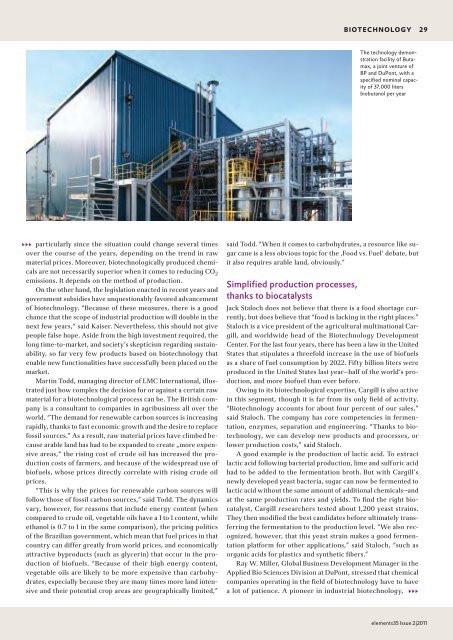Download - Evonik Industries
Download - Evonik Industries
Download - Evonik Industries
You also want an ePaper? Increase the reach of your titles
YUMPU automatically turns print PDFs into web optimized ePapers that Google loves.
333 particularly since the situation could change several times<br />
over the course of the years, depending on the trend in raw<br />
mate rial prices. Moreover, biotechnologically produced chemicals<br />
are not necessarily superior when it comes to reducing CO2 emissions. It depends on the method of production.<br />
On the other hand, the legislation enacted in recent years and<br />
government subsidies have unquestionably favored advancement<br />
of biotechnology. “Because of these measures, there is a good<br />
chance that the scope of industrial production will double in the<br />
next few years,“ said Kaiser. Nevertheless, this should not give<br />
people false hope. Aside from the high investment required, the<br />
long time-to-market, and society’s skepticism regarding sustainability,<br />
so far very few products based on biotechnology that<br />
enable new functionalities have successfully been placed on the<br />
market.<br />
Martin Todd, managing director of LMC International, illustrated<br />
just how complex the decision for or against a certain raw<br />
material for a biotechnological process can be. The British company<br />
is a consultant to companies in agribusiness all over the<br />
world. “The demand for renewable carbon sources is increasing<br />
rapidly, thanks to fast economic growth and the desire to replace<br />
fossil sources.” As a result, raw material prices have climbed because<br />
arable land has had to be expanded to create „more expensive<br />
areas,“ the rising cost of crude oil has increased the production<br />
costs of farmers, and because of the widespread use of<br />
biofuels, whose prices directly correlate with rising crude oil<br />
prices.<br />
“This is why the prices for renewable carbon sources will<br />
follow those of fossil carbon sources,” said Todd. The dynamics<br />
vary, however, for reasons that include energy content (when<br />
compared to crude oil, vegetable oils have a 1 to 1 content, while<br />
ethanol is 0.7 to 1 in the same comparison), the pricing politics<br />
of the Brazilian government, which mean that fuel prices in that<br />
country can differ greatly from world prices, and economically<br />
attractive byproducts (such as glycerin) that occur in the production<br />
of biofuels. “Because of their high energy content,<br />
vegetable oils are likely to be more expensive than carbohydrates,<br />
especially because they are many times more land intensive<br />
and their potential crop areas are geographically limited,”<br />
BIoteCHnoLoGY 29<br />
The technology demonstra<br />
tion facility of Butamax,<br />
a joint venture of<br />
BP and DuPont, with a<br />
specified nominal capacity<br />
of 37,000 liters<br />
biobutanol per year<br />
said Todd. “When it comes to carbohydrates, a resource like sugar<br />
cane is a less obvious topic for the ‚Food vs. Fuel‘ debate, but<br />
it also requires arable land, obviously.”<br />
Simplified production processes,<br />
thanks to biocatalysts<br />
Jack Staloch does not believe that there is a food shortage currently,<br />
but does believe that “food is lacking in the right places.”<br />
Staloch is a vice president of the agricultural multinational Cargill,<br />
and worldwide head of the Biotechnology Development<br />
Center. For the last four years, there has been a law in the United<br />
States that stipulates a threefold increase in the use of biofuels<br />
as a share of fuel consumption by 2022. Fifty billion liters were<br />
produced in the United States last year—half of the world‘s production,<br />
and more biofuel than ever before.<br />
Owing to its biotechnological expertise, Cargill is also active<br />
in this segment, though it is far from its only field of activity.<br />
“Biotechnology accounts for about four percent of our sales,”<br />
said Staloch. The company has core competencies in fermentation,<br />
enzymes, separation and engineering. “Thanks to biotechnology,<br />
we can develop new products and processes, or<br />
lower production costs,” said Staloch.<br />
A good example is the production of lactic acid. To extract<br />
lactic acid following bacterial production, lime and sulfuric acid<br />
had to be added to the fermentation broth. But with Cargill’s<br />
newly developed yeast bacteria, sugar can now be fermented to<br />
lactic acid without the same amount of additional chemicals—and<br />
at the same production rates and yields. To find the right biocatalyst,<br />
Cargill researchers tested about 1,200 yeast strains.<br />
They then modified the best candidates before ultimately transferring<br />
the fermentation to the production level. “We also recognized,<br />
however, that this yeast strain makes a good fermentation<br />
platform for other applications,” said Staloch, “such as<br />
organic acids for plastics and synthetic fibers.”<br />
Ray W. Miller, Global Business Development Manager in the<br />
Applied Bio Sciences Division at DuPont, stressed that chemical<br />
companies operating in the field of biotechnology have to have<br />
a lot of patience. A pioneer in industrial biotechnology,<br />
333<br />
elements35 Issue 2|2011
















